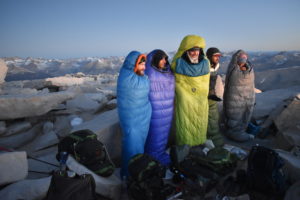Let’s talk about Down vs. Synthetic, shall we?
Ahh the age-old debate amongst us outdoorsy folk. Down vs. synthetic. In the retail world, one of the first questions customers will ask us when deciding what bag to get is, “Which is warmer?”. Well, that’s a loaded question. So I’m here to break it down for you and discuss down vs. synthetic sleeping bags in a bit more detail. A knowledge bomb, if you will.
Let’s dive in and figure out how to choose the best sleeping bag for you, Down vs. Synthetic.
What’s the Difference Between Down and Synthetic Sleeping Bags?
For starters, if you want to save money, go with synthetic. If you want to save weight, I’d recommend down. The type of gear that we decide to take with us on our adventures is determined by the environment and the weather. Down is a great option on just about any adventure, except once it gets wet, it’s pretty much useless. Synthetic is known for remaining somewhat reliable if it gets wet.
So, what environment do you spend more time in? Is the possible wet factor going to be an issue? Once you figure out the answer to these questions, we will discuss the warmth-to-weight ratio. Are you a snow camper or an ultra-light backpacker? Are you a river rat or an alpinist? A down bag with the same temperature rating as a synthetic bag will be significantly lighter. It will also pack down a lot smaller. This is a major determining factor that you must decide. What’s more important to you?
Let’s say that you’re going on a week long backpack through the Olympic National Forest in northern Washington, in a region that gets up to 170 inches of rain a year. Well, that rainfall is definitely welcomed by the lush, temperate rainforest. Not so ideal for your down sleeping bag though. I personally like to own one of each type of bag for this very reason. Both down and synthetic are good sleeping bags. They both have pros and cons, but each rise to the occasion when the respected environment calls for it. I know, not everyone wants to pay for two bags. Just think about the environments you see yourself camping at the majority of they time and narrow it down that way.

Down vs. Synthetic Sleeping Bag Details
We describe the warmth in down by its “fill-power”. This is basically a measurement of cubic inches an ounce of down can fill inside a lab container. The higher the fill-power, the more air gets trapped between the down, therefore, making it warmer. This requires less filling, making for a lighter bag. Synthetic insulation is made from polyester fibers. The fact that it has a higher warmth-to-weight ratio affects its compressibility.
The goal of insulation is to slow the transfer of heat from your body by trapping it in a layer of air around you. Air is a poor heat conductor and a fantastic insulator. The loftier the insulation, the higher the warmth-to-weight ratio. Both down and synthetic insulation can provide these magical pockets for warm air to settle, and each has its pros and cons.
Just keep in mind, all of this weight-saving talk goes out the window in a damp environment. You can’t go wrong with a good synthetic bag in this case. Although, there are options for down bags. The Sea-To-Summit Ultra-Sil Compression Dry Sack is the way to go. This is a fully waterproof compression sack with eVent technology, which allows air to be squeezed out but not allowed back in. It is what I personally use with my down bag and what I would recommend to make the most of you space in your backpack.
Durability of Down
Down is exceptionally resilient, capable of being repeatedly stuffed and re-stuffed without compromising its fluffy warmth. A quality down sleeping bag can be expected to last 10 years or more, making them an investment in many nights’ sleep that lessens the sticker shock many of these bags carry.
Was This Helpful?
I hope you found this review helpful. I do my best to keep it short and sweet by cutting out all the unnecessary fluff, but still try to break it down as much as possible to help inform the reader. The goal is to help narrow down your search so you can find all of the information you need in one place. If you have any suggestions or just want some more information on a particular topic, please drop me a line in the comment section below and I’ll get to work! Let me bring the information to you!
If you enjoyed this article, you may also like:
- 10 Best Sleeping Pads of 2020
- Best Backpacking Stoves of 2020
- 10 Best Backpacking Water Filters of 2020
- Top 5 Backpacking Tents of 2020
*Editor’s note: Help support this site by making your next gear purchase through one of the links above. Click a link, buy what you need, and the seller will contribute a portion of the purchase price to support TheEpicReviews unsponsored gear reviews, articles, and hiking guides.


